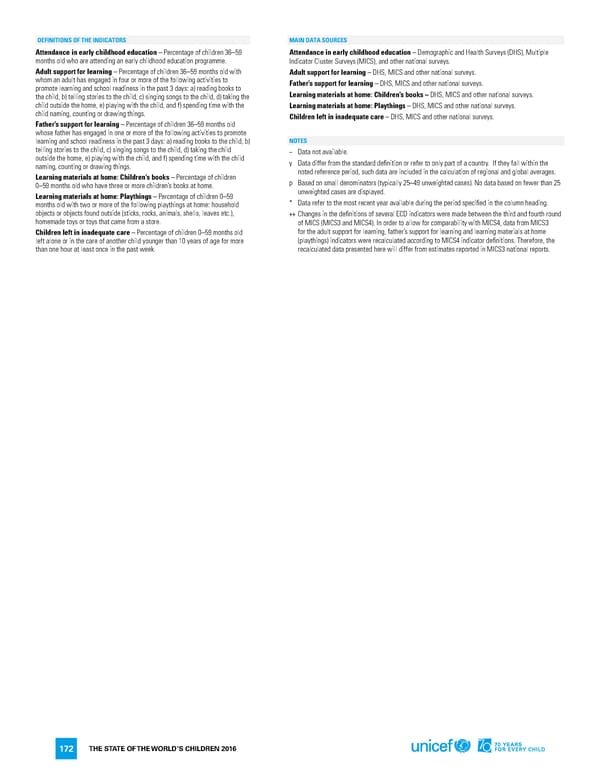DEFINITIONS OF THE INDICATORS MAIN DATA SOURCES Attendance in early childhood education – Percentage of children 36–59 Attendance in early childhood education – Demographic and Health Surveys (DHS), Multiple months old who are attending an early childhood education programme. Indicator Cluster Surveys (MICS), and other national surveys. Adult support for learning – Percentage of children 36–59 months old with Adult support for learning – DHS, MICS and other national surveys. whom an adult has engaged in four or more of the following activities to Father’s support for learning – DHS, MICS and other national surveys. promote learning and school readiness in the past 3 days: a) reading books to Learning materials at home: Children’s books – DHS, MICS and other national surveys. the child, b) telling stories to the child, c) singing songs to the child, d) taking the child outside the home, e) playing with the child, and f) spending time with the Learning materials at home: Playthings – DHS, MICS and other national surveys. child naming, counting or drawing things. Children left in inadequate care – DHS, MICS and other national surveys. Father’s support for learning – Percentage of children 36–59 months old whose father has engaged in one or more of the following activities to promote learning and school readiness in the past 3 days: a) reading books to the child, b) NOTES telling stories to the child, c) singing songs to the child, d) taking the child − Data not available. outside the home, e) playing with the child, and f) spending time with the child y Data differ from the standard definition or refer to only part of a country. If they fall within the naming, counting or drawing things. noted reference period, such data are included in the calculation of regional and global averages. Learning materials at home: Children’s books – Percentage of children p Based on small denominators (typically 25–49 unweighted cases). No data based on fewer than 25 0–59 months old who have three or more children’s books at home. unweighted cases are displayed. Learning materials at home: Playthings – Percentage of children 0–59 * Data refer to the most recent year available during the period specified in the column heading. months old with two or more of the following playthings at home: household objects or objects found outside (sticks, rocks, animals, shells, leaves etc.), ++ Changes in the definitions of several ECD indicators were made between the third and fourth round homemade toys or toys that came from a store. of MICS (MICS3 and MICS4). In order to allow for comparability with MICS4, data from MICS3 Children left in inadequate care – Percentage of children 0–59 months old for the adult support for learning, father’s support for learning and learning materials at home left alone or in the care of another child younger than 10 years of age for more (playthings) indicators were recalculated according to MICS4 indicator definitions. Therefore, the than one hour at least once in the past week. recalculated data presented here will differ from estimates reported in MICS3 national reports. 172 THE STATE OF THE WORLD’S CHILDREN 2016
 70 Years for Every Child Page 190 Page 192
70 Years for Every Child Page 190 Page 192